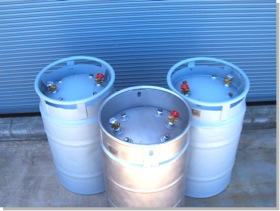EtO Gas Mixtures for Ethylene Oxide Sterilization
An ethylene oxide (EtO) cycle recipe is generally based on the control of five physical parameters: temperature, pressure, humidity, EtO concentration and time.
The EtO concentration has a direct impact on the exposure time as well as the production cost. The higher the EtO concentration is inside the chamber, the less the exposure time is, but the EtO consumption is higher. For this reason, it’s important to find the appropriate balance for each of the products requiring sterilization, while at the same time achieving economical production and safe sterilization. Using these guiding principles, a normal EtO concentration typically is found between 300 mg/l and 800 mg/l.
In order to reach such a concentration, various EtO mixtures are available on the market. The drums can be either filled with 100 percent of EtO liquid and pressurized with nitrogen (N2) at a pressure determined by the country of delivery, or with “X percent” of EtO liquid mixed with carbon dioxide (CO2) liquid. The value of “X” is variable and determined by the sterilization user.
One of the mixtures used for drum filling is 8.5 percent EtO with 91.5 percent CO2. The importance of such a mixture is at that CO2 level, the atmosphere inside the drum is not potentially explosive. The great advantage of this approach is that the entire installation doesn’t have to be classified in terms of explosion risks and there is no requirement to fulfil regulations—such as Atmopsheric Explosible (ATEX) and National Electric Code directives. Typically, this makes the equipment more economical compared to the classified case, although it has its own drawbacks.
The major problem is that the pressure inside the chamber has to be relatively high in order to maintain the desired EtO concentration. The consequences are that the chamber structure needs to be stronger to resist the pressure increase. A 100 percent EtO mixture can properly sterilize products having only negative pressure inside the chamber but that’s not the case with the 8.5 percent/91.5 percent mixture, where the exposure pressure could reach more than 3 bars. If the internal volume of the sterilizer is relatively small (hospital applications for example) it is feasible to use this approach, but for larger scale industrial processes (accommodating several pallets at one time) it becomes less practical.
In addition, the pressure inside the drum is close to 50 bars, from which it’s clear that the operators have to pay very close attention during the drum change. Also, the EtO remains toxic and carcinogenic even at the low concentration, so at that pressure, even a small leak could lead to a high parts-per-million level in the atmosphere.
Alternatively, it’s possible to use drums with a mixture higher than 8.5 percent ETO. Most of the gas manufacturers are in agreement that above this concentration the atmosphere becomes potentially explosive and as a result the entire process has to be very well controlled, in accordance with the explosion risk norm of the country concerned. The European ATEX norm is one of the most stringent regulations for installations with potential explosion risks.
Operating between 8.5/91.5 percent EtO mixture and 90/10 percent mixture is actually not of much interest, since the pressure inside the chamber is still significant and the mixture is always potentially explosive. The 90/10 percent EtO mixture is quite well accepted in industrial sterilization as it allows operation with a low pressure in the sterilizer.
One of the drawbacks of that mixture is that due to the pressurization by the CO2 inside the drum, the EtO concentration in the drum is different with a full drum than with an empty drum (CO2 is consumed in maintaining a constant pressure inside the drum so EtO concentration is increased). This can be a problem for cycle validation because the control of EtO injection into the chamber is based upon the pressure difference and the EtO concentration inside the chamber could change. For this reason, when using a mixture of this type, it’s important to validate a cycle (during performance qualification) with a new drum.

The last type of mixture is 100 percent EtO, pressurized with N2. In this case, an additional N2 inlet to the drum is required, to maintain a constant pressure. This mixture is becoming more popular, especially because it has less of an environmental impact than the CO2 mixture. In addition, the inert gas N2 is normally more economical than the CO2, making the mixture more attractive from the industrial point of view. The last advantage is that the products could be sterilized with only negative pressure in the chamber.
Note that ethylene oxide is one of the only gases able to generate an explosion without the presence of air, since its higher explosive limit is 100 percent, which makes the gas very unstable. Temperature vs. pressure curves published by the manufacturer must be followed to ensure safe conditions.
Romain Siegel, is the product manager for Telstar’s Sterilization Systems business. The Life Science Solutions division of Spain-based Telstar provides equipment solutions for the pharmaceutical, medical-hospital, biotech, laboratories and related industries.
Article source: MPO










